
Pterosaurs were flying reptiles of the extinct clade or order Pterosauria. They existed during most of the Mesozoic: from the Late Triassic to the end of the Cretaceous. Pterosaurs are the earliest vertebrates known to have evolved powered flight. Their wings were formed by a membrane of skin, muscle, and other tissues stretching from the ankles to a dramatically lengthened fourth finger.
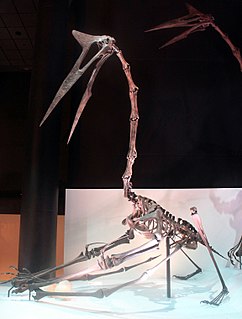
Quetzalcoatlus is a pterosaur known from the Late Cretaceous period of North America ; it was one of the largest known flying animals of all time. Quetzalcoatlus is a member of the family Azhdarchidae, a family of advanced toothless pterosaurs with unusually long, stiffened necks. Its name comes from the Aztec feathered serpent god, Quetzalcoatl, in Nahuatl. The type species is Q. northropi, named by Douglas Lawson in 1975; the genus also includes the smaller species Q. lawsoni, which was known for many years as an unnamed species before being named by Brian Andres and Wann Langston Jr. (posthumously) in 2021.

Azhdarchidae is a family of pterosaurs known primarily from the Late Cretaceous Period, though an isolated vertebra apparently from an azhdarchid is known from the Early Cretaceous as well. Azhdarchids included some of the largest known flying animals of all time, but smaller cat-size members have also been found. Originally considered a sub-family of Pteranodontidae, Nesov (1984) named the Azhdarchinae to include the pterosaurs Azhdarcho, Quetzalcoatlus, and Titanopteryx. They were among the last known surviving members of the pterosaurs, and were a rather successful group with a worldwide distribution. By the time of the end-Cretaceous mass extinction, most pterosaur families except for the Azhdarchidae disappear from the fossil record, but recent studies indicate a wealth of pterosaurian fauna, including pteranodontids, nyctosaurids, tapejarids and several indeterminate forms. In several analyses, some taxa such as Navajodactylus, Bakonydraco and Montanazhdarcho were moved from Azhdarchidae to other clades.

Tupuxuara is a genus of large, crested, and toothless pterodactyloid pterosaur from the Early Cretaceous period of what is now the Romualdo Formation of the Santana Group, Brazil, about 112 million years ago. Tupuxuara is a close relative of Thalassodromeus, and both form a group that is either called Thalassodrominae or Thalassodromidae.

Thalassodromeus is a genus of pterosaur that lived in what is now Brazil during the Early Cretaceous period, about 100 million years ago. The original skull, discovered in 1983 in the Araripe Basin of northeastern Brazil, was collected in several pieces. In 2002, the skull was made the holotype specimen of Thalassodromeus sethi by palaeontologists Alexander Kellner and Diogenes de Almeida Campos. The generic name means "sea runner", and the specific name refers to the Egyptian god Seth due to its crest being supposedly reminiscent of Seth's crown. Other scholars have pointed out that the crest was instead similar to the crown of Amon. A jaw tip was assigned to T. sethi in 2005, became the basis of the new genus Banguela in 2014, and assigned back to Thalassodromeus as the species T. oberlii in 2018. Another species was named in 2015 based on a supposed crest fragment, but this was later shown to be part of a turtle shell.

Tapejaridae are a family of pterodactyloid pterosaurs from the Cretaceous period. Members are currently known from Brazil, England, Hungary, Morocco, Spain, the United States, and China. The most primitive genera were found in China, indicating that the family has an Asian origin.

Hatzegopteryx is a genus of azhdarchid pterosaur found in the late Maastrichtian deposits of the Densuş Ciula Formation, an outcropping in Transylvania, Romania. It is known only from the type species, Hatzegopteryx thambema, named by Buffetaut et al. in 2002 based on parts of the skull and humerus. Additional specimens, including a neck vertebra, were later placed in the genus, representing a range of sizes. The largest of these remains indicate it was among the biggest pterosaurs, with an estimated wingspan of 10 to 12 metres.
Eopteranodon is a genus of tapejarid pterosaur from the Aptian-age Lower Cretaceous Yixian Formation of Beipiao City, Liaoning, China. The genus was named in 2005 by paleontologists Lü Junchang and Zhang Xingliao. The type and only species is Eopteranodon lii.

Chaoyangopterus is a genus of chaoyangopterid pterosaur known from a partial skeleton found in Liaoning, China. Chaoyangopterus was found in rocks dating back to the Aptian-age Lower Cretaceous Jiufotang Formation of Dapingfang, Chaoyang.

Azhdarchoidea is a group of pterosaurs within the suborder Pterodactyloidea, more specifically within the group Ornithocheiroidea. Pterosaurs belonging to this group lived throughout the Early and Late Cretaceous periods, with one tentative member, Tendaguripterus, that lived in the Late Jurassic period. The largest azhdarchoids include members of the family Azhdarchidae, examples of these are Quetzalcoatlus, Hatzegopteryx, and Arambourgiania. The Azhdarchoidea has been recovered as either closely related to the Ctenochasmatoidea, as the sister taxon of the Pteranodontoidea within the Ornithocheiroidea, or within the Tapejaroidea, which in turn was also within the Ornithocheiroidea.

Ornithocheiridae is a group of pterosaurs within the suborder Pterodactyloidea. These pterosaurs were among the last to possess teeth. Members that belong to this group lived from the Early to Late Cretaceous periods, around 140 to 90 million years ago.
Pterosaurs included the largest flying animals ever to have lived. They are a clade of prehistoric archosaurian reptiles closely related to dinosaurs. Species among pterosaurs occupied several types of environments, which ranged from aquatic to forested. Below is a list that comprises the largest pterosaurs known as of 2016.
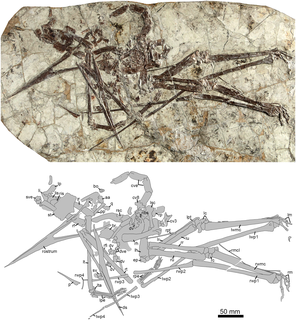
Chaoyangopteridae is a family of pterosaurs within the larger group Azhdarchoidea. Chaoyangopterids lived mostly during the Early Cretaceous period, though possible members, Microtuban, Xericeps and Argentinadraco, may extend the fossil range to the Late Cretaceous.
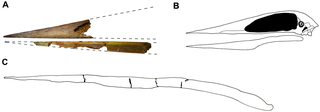
Alanqa is a genus of pterodactyloid pterosaur from the Late Cretaceous period of what is now the Kem Kem Beds of southeastern Morocco. The name Alanqa comes from the Arabic word العنقاءal-‘Anqā’, for a mythical bird of Arabian culture.

Thalassodrominae or Thalassodromidae is a group of azhdarchoid pterosaurs from the Cretaceous period. Its traditional members come from Brazil, however, other possible members also come from other places, including the United States, Morocco, and Argentina. Thalassodrominae is considered either to be a subfamily within the pterosaur family Tapejaridae, or as a distinct family, Thalassodromidae, within the clade Neoazhdarchia, closely related to dsungaripterids or azhdarchids.
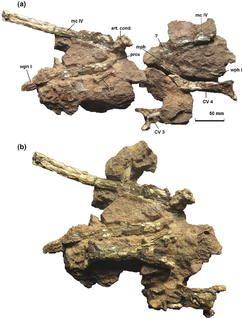
Eurazhdarcho is a genus of azhdarchid pterosaur from the Late Cretaceous period of what is now the Transylvanian Basin of Romania. Its fossil remains dated back 69 million years ago.
Radiodactylus is an extinct genus of non-azhdarchid azhdarchoid pterosaur known from the Early Cretaceous period of what is now Texas, southern United States. It contains a single species, Radiodactylus langstoni.
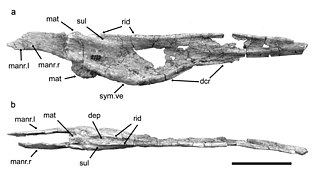
Argentinadraco is an extinct genus of azhdarchoid pterosaur from the Late Cretaceous Portezuelo Formation of Argentina. It contains a single species, A. barrealensis, named in 2017 by Alexander Kellner and Jorge Calvo. Argentinadraco is unusual for bearing a bottom jaw with a concave bottom edge, as well as a pair of ridges and depressions on the top surface. These features distinguish it from all other azhdarchoid groups, complicating its assignment, but it may belong to the Chaoyangopteridae. The ridges on the lower jaw may have been used to feed on small invertebrates in loose sediment within the system of lakes and rivers that it resided in.

Cryodrakon is a genus of azhdarchid pterosaur that lived during the Late Cretaceous period in what is now Canada. It contains a single species, Cryodrakon boreas, recovered from the Dinosaur Park Formation.































